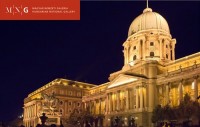The man in decorative Turkish dress seen in the painting is a young member of the Hungarian aristocracy, Count Edmund Zichy who probably had ordered the painting as a reminder of his journey to the East. In the 19th century, portraits like The Emir of Lebanon, in which the subject is portrayed in costume, in a role unconnected to his daily life, were quite fashionable. The painting reflects 19th-century interests in Eastern culture, a trend known as Orientalism. In 19th-century Europe, the Middle East and Far East were generally perceived as diametrically opposed to the western world, and people’s understanding was built as much on stereotypes, desires, and fears as on any real experiences in the East. One of the most popular stereotypes about the East was the slow pace of life, the absence of any measure of time, in contrast to the accelerated development in the West brought about by industrialization. Paintings such as Borsos’s expressed this idea by showing people from the East musing, relaxing in a comfortable and lavish environment.
en

